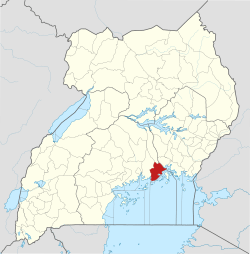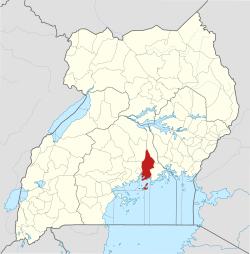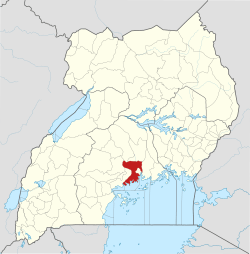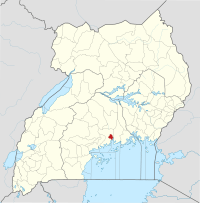Kampala–Jinja Expressway
The Kampala–Jinja Expressway, also known as the Jinja–Kampala Expressway, is a proposed four-lane toll highway in Uganda, linking Kampala, the capital and largest city of Uganda, with the city of Jinja in the Eastern Region of Uganda.[1]
| Kampala–Jinja Expressway | |
|---|---|
| Route information | |
| Length | 47.9 mi (77.1 km) |
| History | Designation expected in 2020 Completion expected in 2026 |
| Major junctions | |
| West end | Nakawa |
| East end | New Jinja Bridge, Njeru |
| Highway system | |
| Roads in Uganda | |
Location
The expressway will start at Nakawa, a neighborhood in Nakawa Division in the eastern part of Kampala, go through Namanve and Mukono in Mukono District, and end at the New Jinja Bridge in Njeru.[2] The entire expressway will be a four-lane, dual carriageway, with limited access.[3]
Overview
The current Kampala-Jinja Highway, highway A109 on the map, forms part of the Northern Corridor of the Trans-Africa Highway, linking the Indian Ocean port of Mombasa, Kenya with the Atlantic Ocean port of Matadi, Democratic Republic of the Congo (DRC). The section of A109 between Jinja and Kampala is the busiest and most congested road in Uganda. It is the main import/export route for land-locked Uganda, Rwanda, Burundi, and eastern DRC. The 77 kilometres (48 mi) expressway will pass to the south of the existing Kampala–Jinja Highway and is planned as a toll-road.[3]
In 2010, the Ugandan government engaged the World Bank as transaction adviser. They hired Integrated Transport Planning (ITP), a United Kingdom-based transportation consulting firm, to conduct feasibility studies and road design. A core investor will be identified who will build, own, and operate the toll road for 25 years from the date of commissioning. This public-private-partnership (PPP) arrangement will be used on three other planned expressways, leading in and out of the nation's capital. Trademark East Africa, an affiliate of ITP, will provide oversight support to the Uganda National Roads Authority (UNRA) in the management of PPP preparation, procurement, and implementation.[4]
History
Construction was expected to begin in 2015, with commissioning planned for 2020. The expressway will be a toll-road, with vehicles that use it needing fittings with electronic billing devices. The construction contract will be awarded once the core investor in the toll road is identified and approved.[5]
The exact cost of the project has not been finalized. Estimates have varied from UGX:800 billion[6] to a high of UGX:5.5 trillion (US$1.5 billion).[2][7]
In June 2014, the UNRA selected the International Finance Corporation as lead transaction advisor to assess the potential to develop the 77 kilometres (48 mi) expressway on a public private partnership basis. Spea Engineering was hired to assist UNRA select one or more investors to design, build, finance, and operate the expressway.[8] In July 2014 at the Financing Summit for Africa's Infrastructure that took place in Dakar, Senegal, the Common Market for Eastern and Southern Africa (COMESA) identified the expressway as a priority project, one of the six infrastructure projects to be developed before 2020. COMESA allocated US$74 million in funding towards its development.[9]
Recent developments
In June 2016, the government of France, through the French Development Agency (AFD), agreed to lend €180 million (Shs667 billion) to the Ugandan government, towards the construction of this toll expressway. Construction was planned to begin in 2017.[10]
In May 2018, the Uganda National Roads Authority (UNRA), advertised for bids from aspiring developers to design, build, finance, operate and later transfer the project back to the government after recovering their investment in the proposed 95 kilometres (59 mi), US$1 billion road project. The African Development Bank has also offered funding for this project.[11]
In September 2018, UNRA revealed that eight firms had bid to be considered in awarding of the contract for the construction of this highway and the connecting Kampala Southern Bypass Highway. The consortia vying for the contract include (1) China Communications Construction Company & China First Highway Engineering Company Limited (2) A consortium of French and Portuguese firms KJ Connect, Vinci Concessions & Mota-Engil (3) A consortium of Austria & Turkish firms, Strabag & IC Ictas (4) Enkula Expressway Consortium from South Africa (5) A consortium of Chang Chyi Enterprise Company Limited (CCECL) & CRCCIG from China (6) Shapoorji Pacconji Group from India (7) Tecnasol Luisa Goncal from Portugal and (8) South Korean and Chinese firms, comprising the CCKS Consortium.[12]
Financing
In November 2018, the total project cost of the Kampala-Jinja Expressway and the Kampala Southern Bypass Highway was quoted at US$1.55 billion. The funds will be raised through a public private partnership arrangement. The same source reported that the African Development Bank had approved US$229.5 million in sovereign loans to go towards the development of this transportation system.[13]
As of March 2020, the financing of this expressway and the associated Kampala Southern Bypass Highway, are as illustrated in the table below:[14]
| Rank | Development Partner | Contribution in US$ | UGX Equivalent | Percentage | Notes | |
|---|---|---|---|---|---|---|
| 1 | African Development Bank | 229.47 million | 846.40 billion | 15.50 | Loan | |
| 2 | French Development Agency | 105.00 million | 387.30 billion | 7.10 | Loan | |
| 3 | Government of Uganda | 301.17 million | 1,109.36 billion | 20.35 | Equity | |
| 4 | Private Investors | 844.36 million | 3,110.20 billion | 57.05 | Investment | |
| Total | 1,480 million | 5,480 billion | 100.00 | |||
Maps and diagrams
- Map Showing Kampala–Jinja Expressway in relation to Kampala–Jinja Highway Illustration at UNRA Website.
See also
- New Jinja Bridge


References
- Observer Media Limited (14 March 2014). "UNRA: Construction of the Kampala–Jinja Expressway". The Observer (Uganda). Kampala. Retrieved 25 November 2019.
- Rwothungeyo, Billy (28 April 2015). "Kampala-Jinja Expressway Tender To Be Advertised In May". New Vision. Kampala. Retrieved 25 June 2015.
- Baguma, Raymond (26 October 2012). "Kampala-Jinja highway planned for redevelopment". New Vision. Kampala. Retrieved 25 June 2015.
- Ogwang, Joel (12 April 2013). "Govt joins World Bank to build $1.5b road projects". New Vision. Retrieved 12 February 2016.
- Musoke, Ronald (18 January 2014). "Is Shs9bn road repair a waste?". Kampala: The Independent (Uganda). Retrieved 28 July 2014.
- Musisi, Frederic (23 October 2013). "Kampala–Jinja Express Highway to Cost Shs800 Billion". Daily Monitor. Kampala. Retrieved 12 February 2016.
- Musisi, Frederic (23 January 2016). "Uganda: Work On Shs5 Trillion Jinja Expressway to Start in March". Daily Monitor via AllAfrica.com. Kampala. Retrieved 13 February 2016.
- SEI (June 2014). "Uganda – Kampala Jinja Expressway PPP: Technical & Traffic Consultants". Spea-engineering.it (SEI). Retrieved 25 June 2015.
- Nakaweesi, Dorothy (21 July 2014). "Comesa earmarks Shs190 billion for Kampala–Jinja highway expansion". Daily Monitor. Kampala. Retrieved 21 July 2014.
- Musisi, Frederic (3 June 2016). "France pledges Shs667 billion for Kampala-Jinja Expressway project". Daily Monitor. Kampala. Retrieved 3 June 2016.
- AFP (18 May 2018). "Uganda invites bids for $1 billion expressway". The EastAfrican Quoting Agence France-Presse (AFP). Retrieved 18 May 2018.
- Musisi, Frederic (4 September 2018). "Eight firms bid to construct Kampala–Jinja Expressway". Daily Monitor. Kampala. Retrieved 4 September 2018.
- Mutisya, Kawira (6 November 2018). "AfDB approves loan for Kampala–Jinja Expressway project". The Exchange (East Africa). Dar es Salaam. Retrieved 7 November 2018.
- Moses Kyeyune (12 March 2020). "Government to borrow Shs1 trillion for Jinja expressway". Daily Monitor. Kampala. Retrieved 12 March 2020.




